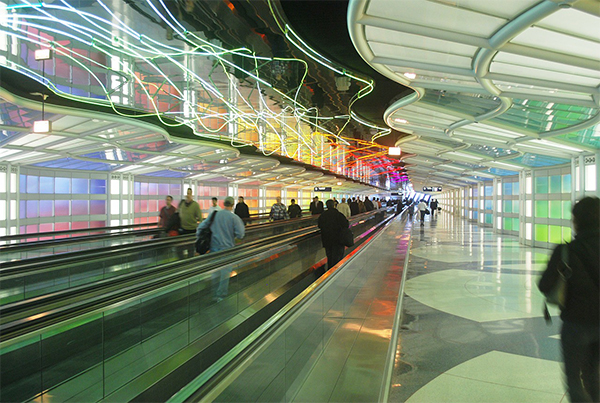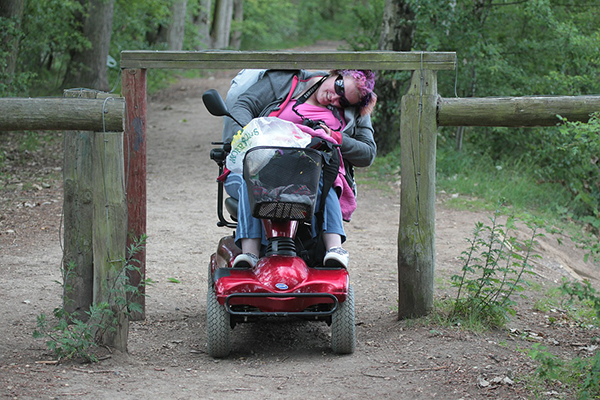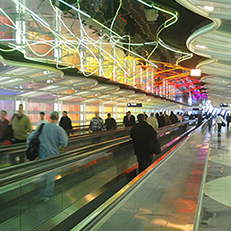
Universal rather than accessible design should be the goal of every architect, builder, developer and facilities manager. Allowing each employee, customer or visitor full and easy use of the total environment, whether that person has a disability or not, is an ongoing process, one that enhances the quality of life of individuals as well as that of society as a whole.
The Whole Building Design Guide says universal design puts people with disabilities on an equal playing field with everyone else, supporting self-reliance and social engagement. It’s smart business, too, the guide says. “For businesses and government, it reduces the economic burden of special programs and services designed to assist individual citizens, clients, or customers.”
A couple of examples from Kansas University’s Community Tool Box shows how simple, yet inclusive, universal design is:
- A nature trail in a park should be built so people using wheelchairs can traverse it as easily as people who are walking, with informational signs accessible to those with visual impairments. The trail should not be labeled in any way: “If it’s just a ‘nature trail,’ people of all sorts will use it, and the people with disabilities among them won’t be singled out and labeled, either.”
- A sensory garden, with plants that have interesting textures as well as those with fragrant leaves, can be made universal by using raised beds. It allows “a hands-on experience easy for pedestrians and wheelchair users.”
Organizations everywhere are realizing the value of going above and beyond the legal requirements as set out by the Americans with Disabilities Act (ADA).
Last year, Brooklyn Borough President Eric Adams launched Access-Friendly NYC, an initiative that will bring a higher level of accessibility in public buildings across the city. Upgrades will include automatic door openers, wheelchair-accessible water fountains, eye-level way-finding signage, training for staff for effective interaction, and more.
If you manage a facility that is anything other than a private club or religious organization, those buildings, even if privately owned, must be accessible. According to the team at Lawyers.com, that includes restaurants, hotels, theaters, supermarkets, shopping malls, parks, health clubs, and private schools and day-care centers.
While there is some leeway when changes to existing structures are either prohibitively expensive to the business owner or extremely difficult to implement structurally, completely barrier-free access is always the goal.
Historic properties are the only buildings and landscapes that may have protected features and spaces. Even the National Park Service admits that “very small or highly significant properties that have never been altered may be extremely difficult to modify.”

A Useful Checklist to Identify Accessibility Issues
That said, there’s a great checklist for existing facilities at the Americans with Disabilities Act website. This can help a building owner or facilities manager identify any accessibility issues that exist, and the checklist includes solutions to bring the property up to code. For example, one question to ask is whether a door handle is operable with a closed fist. If not, the knob should be replaced with a lever or loop handle, or retrofitted with an add-on extension.
Another item on the checklist deals with ensuring that all obstacles in public area pathways are “cane-detectable,” which means the obstacle is “located within 27 inches of the floor or higher than 80 inches, or protruding less than 4 inches from the wall.”
The obvious solution here is to simply remove the obstacle, but for those that are higher, a cane-detectable barrier (such as a planter or piece of furniture) can be placed underneath.
Changes Don’t Have to Be Expensive or Expansive
Bringing a facility into line with ADA requirements, or even going beyond them, can be free of charge. Sometimes, it’s a matter of simply modifying policies regarding the way service is provided to people with disabilities.
One example, in an ADA Small Business Primer, shows that a clothing store only needs to change its one-person per change room rule to comply with the needs of a person who requires the help of a companion to try on clothes.
Similarly, allowing extra snacks at a daycare for a child with diabetes may be a simple alteration to an existing no-snacks policy. That might be all that’s needed to bring the business into ADA compliance.
The ADA’s requirements stop at the point where a change “would result in a fundamental alteration — a change in the essential nature of your business. For example, a clothing store is not required to provide dressing assistance for a customer with a disability if this is not a service provided to other customers.”
If a physical barrier is impeding a customer or client from doing business, the usual solution is some kind of retrofit or alteration. If for some reason removal of the barrier is not possible, the ADA allows alternatives in service provision. So, if you’ve got a shop with steps into the only entrance, and a suitable ramp cannot be installed, you’ve got to provide curbside service to people with disabilities to comply with the ADA.
Interestingly, the high shelves at a supermarket — well beyond the reach of many (whether living with a disability or not) — are compliant with the ADA. The actual ruling is that “shelves may be of any height since they are not subject to the ADA’s reach range requirements.”
Still, angled mirrors for visibility would make it easier for everyone involved, and would probably be a universally useful addition not just in supermarkets but any public space with shelving, such as a library.

Accommodating Invisible Disabilities
Autism Spectrum Disorder
Certain disabilities are easier to plan for than others. Wheelchair users, for example, need to have specific door widths and properly sized restroom facilities. However, when you are dealing with people who have an invisible disability such as autism spectrum disorder (ASD), the needs and solutions vary widely.
According to the Autism Society, more than 3.5 million Americans live with autism spectrum disorders. Some have developmental disabilities that are noticeable, others may have auditory issues or be non-verbal, and still others may function extremely well and be fully integrated in society.
Author, speaker, inventor and professor Dr. Temple Grandin is an expert on autism. She herself has Asperger’s syndrome and is one of the majority of people living with ASDs who do not have intellectual disabilities.
What many with ASDs do have in common is a heightened sensitivity to their environments, including noise. While Grandin says people can be desensitized in a controlled situation over time, immediate steps can be taken by builders and building managers. This includes providing single-person alcoves and private call booths in communal areas, for instance, aided by the addition of acoustic ceiling and wall panels.
Diabetes
Another of the so-called invisible disabilities is diabetes, and some people with the disease have DADs (diabetic alert dogs). As explained by Frank Wisneski on his blog, Black Dogs Rule, these service dogs are trained to alert a diabetic person when her person’s blood sugars are too high or low, a situation that can be immediately life-threatening.
According to the ADA, all service animals must be permitted to accompany the person with a disability to all areas of the facility where customers normally go. Businesses do not have to abandon their buildings’ no-pets policy to accommodate service animals, though, because the ADA does not define a service animal as a pet.

Accommodating Budgets, Too
Budgets are often cited as the reason older buildings are not brought up to code. But before throwing in the trowel, Bob Gammon of American Disabilities Consultants says decision-makers should know that accessibility is often not required throughout the whole of a building.
“What many people don’t realize is that entire buildings do not need to be ADA compliant,” he says. “If a first floor science lab is accessible, the second floor lab doesn’t have to be. A consultant can help guide district leaders through these decisions in order to maximize funds.”
And some of the fixes are minor adjustments, such as the closing speed of doors. Even going beyond the ADA’s requirements toward universal accessibility doesn’t have to be prohibitively expensive. For example, the ADA National Network points out a hotel can simply install a second people, at 43 inches, in room doors to accommodate more guests.
If your business uses a number system to provide customer service, the National Disability Authority in Ireland says you need to consider that some people might not be able to:
- read visual information,
- hear audio information,
- or reach tickets that are very high.
Again, the proposed solutions are simple. Have tickets placed at appropriate heights and ensure staff members are trained to readily assist those who need help, either by providing customers with written information or individual attention as required.
No Parking
Even when a facility is truly inclusive, a facilities manager may need a little extra help. That’s where Mack March’s Parking Mobility software can help. A wheelchair user, Marsh came up with the program as a way to help keep accessible parking for those who need it.
Trained volunteers use the app to send images of illegally parked vehicles to police who have agreed to participate. Offenders are then given the option to either pay the full fine or attend a Parking Mobility education course and have their fine reduced.
Marsh says the program is not meant to be punitive but designed to change behavior. Only four percent of parking spaces are set aside for the 18 percent of the population who need them — and of those designated spots, one-quarter are being abused at any given time, Marsh notes in a video on the site.
Massachusetts State Representative Bruce J. Ayers is going for more punitive action. According to a recent report in The Enterprise, Rep. Ayers wants to raise fines on designated spots parking violations, “On a national scale, Massachusetts has some of the weakest penalties in the country for handicapped parking violators,” he says. Rep. Ayers proposes, too, that those “funds would then be used for improvements towards the municipality’s compliance with the Americans with Disabilities Act.”
Credits:
PublicDomainPicturesmakeitsomarketing
Mampu
©auremar

